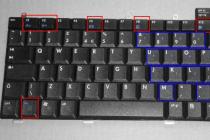Information about the make, model, and alternative names of a particular device, if any.
Design
Information about the dimensions and weight of the device, presented in different units of measurement. Used materials, suggested colors, certificates.
| Width Width information refers to the horizontal side of the device in its standard orientation during use. | 69.7 mm (millimeters) 6.97 cm (centimeters) 0.23 ft 2.74in |
| Height Height information refers to the vertical side of the device in its standard orientation during use. | 139.3 mm (millimeters) 13.93 cm (centimeters) 0.46 ft 5.48in |
| Thickness Information about the thickness of the device in different units measurements. | 6.7 mm (millimeters) 0.67 cm (centimeters) 0.02 ft 0.26in |
| Weight Information about the weight of the device in different units of measurement. | 123 g (grams) 0.27 lbs 4.34oz |
| Volume Approximate volume of the device, calculated from dimensions provided by the manufacturer. Refers to devices with the shape of a rectangular parallelepiped. | 65.05 cm³ (cubic centimeters) 3.95 in³ (cubic inches) |
| Colors Information about the colors in which this device is offered for sale. | White Black Silver Pink Blue Golden |
| Housing materials The materials used to make the body of the device. | Metal Glass |
SIM card
The SIM card is used in mobile devices to store data that certifies the authenticity of mobile service subscribers.
Mobile networks
A mobile network is a radio system that allows multiple mobile devices to communicate with each other.
| GSM GSM (Global System for Mobile Communications) is designed to replace the analogue mobile network (1G). For this reason, GSM is often referred to as a 2G mobile network. It is enhanced by the addition of GPRS (General Packet Radio Services) and later EDGE (Enhanced Data rates for GSM Evolution) technologies. | GSM 850 MHz GSM 900 MHz GSM 1800 MHz GSM 1900 MHz |
| UMTS UMTS is short for Universal Mobile Telecommunications System. It is based on the GSM standard and belongs to 3G mobile networks. Developed by 3GPP and its biggest advantage is to provide more speed and spectral efficiency with W-CDMA technology. | UMTS 850 MHz UMTS 900 MHz UMTS 1900 MHz UMTS 2100 MHz |
| LTE LTE (Long Term Evolution) is defined as fourth generation (4G) technology. It is developed by 3GPP based on GSM/EDGE and UMTS/HSPA to increase the capacity and speed of wireless mobile networks. The subsequent development of technologies is called LTE Advanced. | LTE 800 MHz LTE 850 MHz LTE 900 MHz LTE 1700/2100 MHz LTE 1800 MHz LTE 1900 MHz LTE 2100 MHz LTE 2600 MHz LTE-TDD 2500 MHz (B41) |
Mobile technologies and data rates
Communication between devices in mobile networks is carried out through technologies that provide different data transfer rates.
Operating system
The operating system is the system software that manages and coordinates the operation of the hardware components in the device.
SoC (System on a Chip)
System on a chip (SoC) includes all the most important hardware components of a mobile device in one chip.
| SoC (System on a Chip) System on a chip (SoC) integrates various hardware components such as processor, graphics processor, memory, peripherals, interfaces, etc., as well as the software necessary for their operation. | Qualcomm Snapdragon 410 MSM8916 |
| Technological process Information about the technological process by which the chip is made. The value in nanometers measures half the distance between the elements in the processor. | 28 nm (nanometers) |
| Processor (CPU) The main function of the processor (CPU) of a mobile device is the interpretation and execution of instructions contained in software applications. | ARM Cortex-A53 |
| Processor bit depth The bit depth (bits) of a processor is determined by the size (in bits) of registers, address buses, and data buses. 64-bit processors have higher performance than 32-bit processors, which, in turn, are more productive than 16-bit processors. | 64 bit |
| Instruction Set Architecture Instructions are commands by which the software sets/controls the operation of the processor. Information about the instruction set (ISA) that the processor can execute. | ARMv8 |
| Level 0 Cache (L0) Some processors have an L0 (level 0) cache that is faster to access than L1, L2, L3, etc. The advantage of having such a memory is not only higher performance, but also reduced power consumption. | 4 kB + 4 kB (kilobytes) |
| First level cache (L1) Cache memory is used by the processor to reduce access time to more frequently accessed data and instructions. L1 (level 1) cache is small and much faster than both system memory and other cache levels. If the processor does not find the requested data in L1, it continues to look for them in the L2 cache. With some processors, this search is performed simultaneously in L1 and L2. | 16 kB + 16 kB (kilobytes) |
| Second level cache (L2) L2 (level 2) cache is slower than L1, but in return it has a larger capacity, allowing more data to be cached. It, like L1, is much faster than system memory (RAM). If the processor does not find the requested data in L2, it continues to look for it in the L3 cache (if available) or RAM. | 2048 KB (kilobytes) 2 MB (megabytes) |
| Number of processor cores The processor core executes program instructions. There are processors with one, two or more cores. Having more cores increases performance by allowing many instructions to be executed in parallel. | 4 |
| Processor clock speed The clock speed of a processor describes its speed in terms of cycles per second. It is measured in megahertz (MHz) or gigahertz (GHz). | 1200 MHz (megahertz) |
| Graphics Processing Unit (GPU) Graphics Processing Unit (GPU) handles calculations for various 2D/3D graphic applications. V mobile devices ah it is used most often by games, consumer interface, video applications, etc. | Qualcomm Adreno 306 |
| Clock frequency GPU The speed of work is clock frequency GPU, which is measured in megahertz (MHz) or gigahertz (GHz). | 400 MHz (megahertz) |
| Volume random access memory(RAM) Random access memory (RAM) is used by the operating system and all installed applications. Data stored in RAM is lost when the device is turned off or restarted. | 2 GB (gigabytes) |
| Type of random access memory (RAM) Information about the type of random access memory (RAM) used by the device. | LPDDR3 |
| Number of RAM channels Information about the number of RAM channels that are integrated into the SoC. More channels means more high speeds data transmission. | single channel |
| RAM frequency The frequency of RAM determines its speed, more specifically, the speed of reading / writing data. | 533 MHz (megahertz) |
Built-in memory
Each mobile device has a built-in (non-removable) memory with a fixed amount.
Memory cards
Memory cards are used in mobile devices to increase the storage capacity for storing data.
Screen
The screen of a mobile device is characterized by its technology, resolution, pixel density, diagonal length, color depth, etc.
| Type/technology One of the main characteristics of the screen is the technology by which it is made and on which the image quality of information directly depends. | Super AMOLED |
| Diagonal For mobile devices, the screen size is expressed in terms of its diagonal length, measured in inches. | 5 in 127 mm (millimeters) 12.7 cm (centimeters) |
| Width Approximate Screen Width | 2.45in 62.26 mm (millimeters) 6.23 cm (centimeters) |
| Height Approximate Screen Height | 4.36in 110.69 mm (millimeters) 11.07 cm (centimeters) |
| Aspect Ratio The ratio of the dimensions of the long side of the screen to its short side | 1.778:1 16:9 |
| Permission Screen resolution indicates the number of pixels vertically and horizontally on the screen. More a high resolution means sharper image detail. | 720 x 1280 pixels |
| Pixel Density Information about the number of pixels per centimeter or inch of the screen. Higher density allows information to be shown on the screen in clearer detail. | 294 ppi (pixels per inch) 115ppm (pixels per centimeter) |
| Color depth Screen color depth reflects the total number of bits used for the color components in a single pixel. Information about the maximum number of colors the screen can display. | 24 bit 16777216 flowers |
| Screen area Approximate percentage of screen space on the front of the device. | 71.21% (percentage) |
| Other characteristics Information about other functions and features of the screen. | capacitive Multitouch |
Sensors
Different sensors perform different quantitative measurements and convert physical indicators into signals that are recognized by the mobile device.
Main camera
The main camera of a mobile device is usually located on the back of the case and is used for taking photos and videos.
| Sensor model Information about the manufacturer and model of the photo sensor used in the device's camera. | Sony IMX135 Exmor RS |
| Sensor type Digital cameras use photo sensors to take pictures. The sensor, as well as the optics, is one of the main factors in the quality of a camera in a mobile device. | CMOS (complementary metal-oxide semiconductor) |
| Sensor size Information about the size of the photosensor used in the device. Typically, cameras with a larger sensor and lower pixel density offer more high quality images despite the lower resolution. | 4.69 x 3.52 mm (millimeters) 0.23in |
| Pixel size The smaller pixel size of the photosensor allows more pixels to be used per unit area, thus increasing resolution. On the other hand, a smaller pixel size can have a negative impact on image quality when high levels light sensitivity (ISO). | 1.136 µm (micrometers) 0.001136 mm (millimeters) |
| crop factor The crop factor is the ratio between the dimensions of a full-frame sensor (36 x 24mm, equivalent to a frame of standard 35mm film) and the dimensions of the device's photosensor. The number shown is the diagonal ratio of the full-frame sensor (43.3 mm) and the photosensor specific device. | 7.38 |
| ISO (light sensitivity) ISO values determine the light sensitivity level of the photosensor. A lower value means weaker light sensitivity and vice versa - higher values mean higher light sensitivity, i.e. better ability of the sensor to work in low light conditions. | 100 - 800 |
| Diaphragm Aperture (f-number) is the size of the aperture opening that controls the amount of light reaching the photosensor. A lower f-number means the aperture is larger. | f/2.0 |
| Flash type The most common types of flashes in mobile devices cameras are LED and xenon flashes. LED flashes give a softer light and, unlike brighter xenon flashes, are also used for video shooting. | LED |
| Image Resolution One of the main characteristics of mobile device cameras is their resolution, which indicates the number of pixels in the horizontal and vertical direction of an image. | 4128 x 3096 pixels 12.78 MP (megapixels) |
| Video resolution Information about the maximum supported resolution for video recording by the device. | 1920 x 1080 pixels 2.07 MP (megapixels) |
| Video - frame rate/frames per second. Information about the maximum number of frames per second (fps) supported by the device when shooting video at the maximum resolution. Some of the main standard shooting and video playback speeds are 24p, 25p, 30p, 60p. | 30 fps (frames per second) |
| Specifications Information about other software and hardware features related to the main camera and improving its functionality. | autofocus digital zoom geo tags panoramic shooting HDR shooting Touch focus Face recognition Adjusting the white balance ISO setting Exposure compensation Scene Selection Mode |
Additional camera
Additional cameras are usually mounted above the screen of the device and are mainly used for video calls, gesture recognition, etc.
Audio
Information about the type of speakers and audio technologies supported by the device.
Radio
The radio of the mobile device is a built-in FM receiver.
Location determination
Information about navigation and location technologies supported by the device.
WiFi
Wi-Fi is a technology that provides wireless communication for short distance data transmission between different devices.
Bluetooth
Bluetooth is a standard for secure wireless data transfer between different types of devices over short distances.
| Version There are several Bluetooth versions, with each subsequent one improving communication speed, coverage, making it easier to discover and connect devices. Information about the Bluetooth version of the device. | 4.0 |
| Specifications Bluetooth uses different profiles and protocols to provide more fast exchange data, power savings, improved device discovery, and more. Some of these profiles and protocols that the device supports are shown here. | A2DP (Advanced Audio Distribution Profile) AVRCP (Audio/Visual remote control profile) EDR (Enhanced Data Rate) HFP (Hands Free Profile) HID (Human Interface Profile) HSP (Headset Profile) LE (Low Energy) MAP (Message Access Profile) OPP (Object Push Profile) PAN (Personal Area Networking Profile) PBAP/PAB (Phone Book Access Profile) SAP/SIM/rSAP (SIM Access Profile) |
USB
USB (Universal Serial Bus) is an industry standard that allows different electronic devices to communicate.
Headphone jack
This is an audio connector, which is also called an audio jack. The most widely used standard in mobile devices is the 3.5mm headphone jack.
Connecting devices
Information about other important connection technologies supported by the device.
Browser
A web browser is a software application for accessing and viewing information on the Internet.
| Browser Information about some of the key features and standards supported by the device's browser. | HTML HTML5 CSS 3 |
Audio file formats/codecs
Mobile devices support various audio file formats and codecs that store and encode/decode digital audio data, respectively.
Video file formats/codecs
Mobile devices support various video file formats and codecs, which store and encode/decode digital video data, respectively.
Battery
Mobile device batteries differ from each other in their capacity and technology. They provide the electrical charge they need to function.
| Capacity The capacity of a battery indicates the maximum charge it can store, measured in milliamp-hours. | 2300 mAh (milliamp-hours) |
| Type The type of battery is determined by its structure and, more specifically, by the chemicals used. Exists different types batteries, with lithium-ion and lithium-ion polymer batteries most commonly used in mobile devices. | Li-Ion (Li-Ion) |
| Talk time 2G Talk time in 2G is the period of time during which the battery is completely discharged during a continuous conversation in a 2G network. | 15 h (hours) 900 min (minutes) 0.6 days |
| 3G talk time Talk time in 3G is the period of time during which the battery is completely discharged during a continuous conversation in a 3G network. | 15 h (hours) 900 min (minutes) 0.6 days |
| Adapter output power Information about the strength of the electric current (measured in amperes) and the electric voltage (measured in volts) that the Charger (output power). Higher power output ensures faster battery charging. | 5 V (volts) / 1.5 A (amps) |
| Specifications Information about some additional features of the device's battery. | Fixed |
Specific Absorption Rate (SAR)
SAR levels refer to the amount of electromagnetic radiation absorbed by the human body while using a mobile device.
| SAR level for head (EU) The SAR level indicates maximum amount electromagnetic radiation that the human body is exposed to when holding a mobile device next to the ear in a conversation position. In Europe, the maximum allowable SAR value for mobile devices is limited to 2 W/kg per 10 grams of human tissue. This standard established by CENELEC in accordance with IEC standards following ICNIRP guidelines of 1998. | 0.23 W/kg (watt per kilogram) |
| Body SAR (EU) The SAR level indicates the maximum amount of electromagnetic radiation that the human body is exposed to when holding a mobile device at hip level. The maximum allowed SAR value for mobile devices in Europe is 2 W/kg per 10 grams of human tissue. This standard has been established by CENELEC following the 1998 ICNIRP guidelines and IEC standards. | 0.403 W/kg (watt per kilogram) |
| Head SAR (US) The SAR level indicates the maximum amount of electromagnetic radiation that the human body is exposed to when holding a mobile device near the ear. The maximum value used in the US is 1.6 W/kg per gram of human tissue. Mobile devices in the US are controlled by the CTIA and the FCC conducts tests and sets their SAR values. | 0.648 W/kg (watt per kilogram) |
| Body SAR (US) The SAR level indicates the maximum amount of electromagnetic radiation that the human body is exposed to when holding a mobile device at hip level. The highest acceptable SAR value in the US is 1.6 W/kg per gram of human tissue. This value is set by the FCC, and the CTIA controls whether mobile devices comply with this standard. | 0.478 W/kg (watt per kilogram) |
Smartphone Reviews
10-04-2016
After the furore around Samsung Alpha, the company introduced in 2015 new series A - the manufacturer's first all-metal smartphones. This included three models A3, A5, A7. At the beginning of 2016, the entire A line was updated, became more advanced, and the price increased accordingly. Take for consideration samsung galaxy A5 SM-A500H 2015. Initially, the cost was greatly inflated, since the model, having average characteristics, cost as a full-fledged flagship. Samsung A5 is classified as a fashion device.
Contents of delivery
The model is delivered in a blue box, on which the advantages of the device and technical characteristics are listed on the back. The package includes branded vacuum headphones, interchangeable nozzles on them, network adapter and a USB cable, a clip to remove the Sim tray, a quick start guide and a warranty.
Design
Case Samsung The Galaxy A5 is all metal. During production, an additional special coating was applied to the metal and it was also painted on top. The model is available in the following colors: black, silver, white, pink, gold, light blue. Visually, the gadget seems plastic and even to the touch it is difficult to determine the metal. The side frame is painted to match the rear panel. The gadget is one-piece, its weight is only 123 grams, the thickness is 6.7 mm.
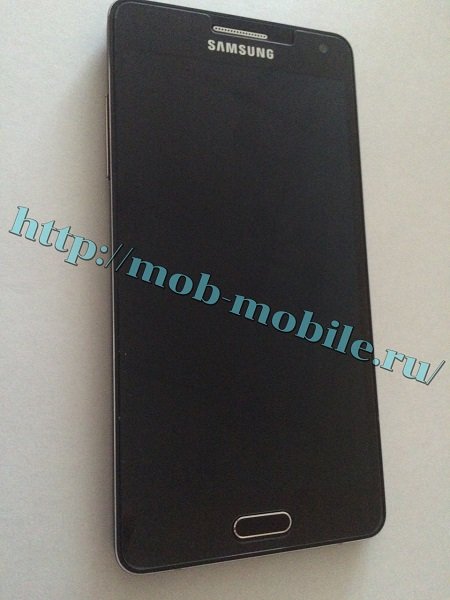
The rear panel houses the camera, flash and speaker grille. The camera module sticks out a little, so the sound of a lying smartphone is not muffled.
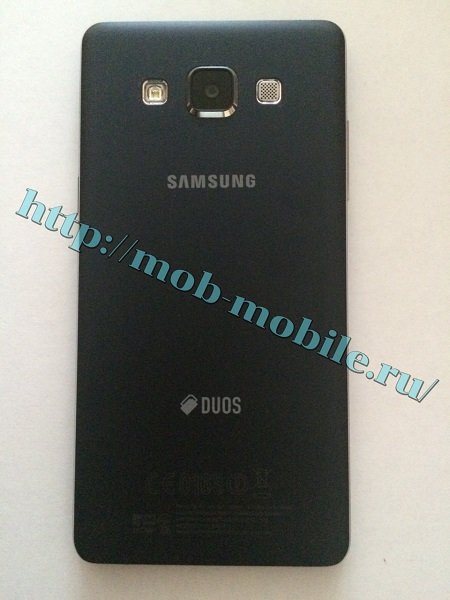
On the left panel there is a volume control button, on the right panel there is a power button, two slots for SIM cards (either a SIM card or a memory card can be inserted into the second slot), at the bottom there is a 3.5mm audio output and a MicroUSB 2.0 connector. There is nothing on the top end.
![]()
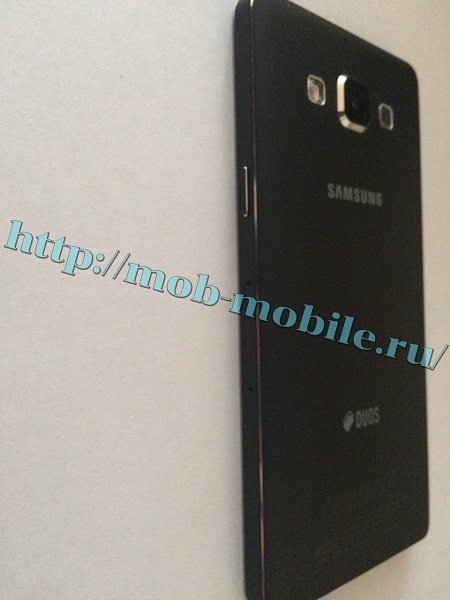
Gorilla Glass protects the front of the gadget, but despite this, the smartphone is quite easy to scratch. The glass is directly adjacent to the metal frame. Above is the earpiece, camera and sensors. Below in the middle is a mechanical key, and on both sides of it - touch buttons.
The Samsung A5 does not have an LED alert sensor. The gadget does not support wireless charging and not protected from moisture and dust.
Screen
Diagonal Samsung A5 is 5 inches. The smartphone is equipped with a Super AMOLED matrix. Screen resolution - only 1280x720 (pixel density - 294 ppi). Brightness, contrast, and viewing angles are traditionally Samsung. Multi-touch processes 10 touches simultaneously, but does not respond to gloves.
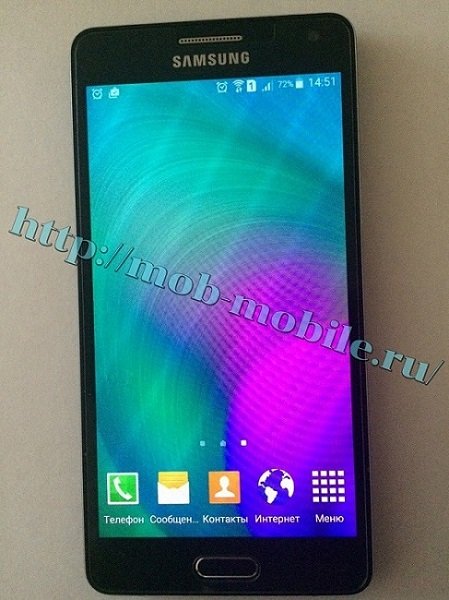
The screen has excellent brightness (it is set manually or automatically), and also has excellent anti-glare properties. The disadvantage is the modulation of brightness, which can cause eye fatigue for flicker-sensitive users.
Photo/video camera
The front camera is 5-megapixel, video is shot at a resolution of 1080p. The camera features are enough to take high-quality selfies. The main camera is equipped with a 13-megapixel module, autofocus, LED flash. Shooting modes are standard: portrait, night, panoramic.
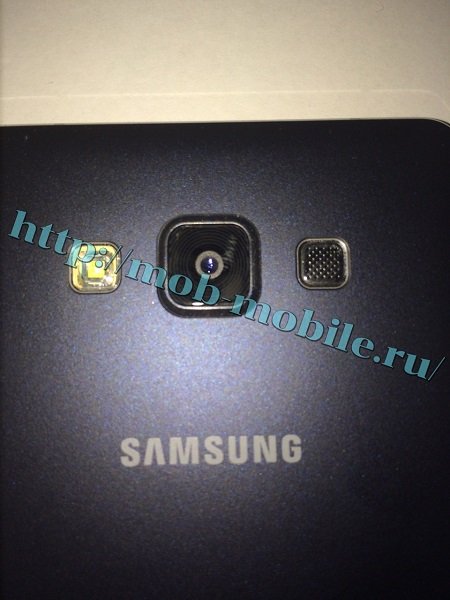
The disadvantages include:
- lack of intelligent optical stabilization;
- no fast and slow motion video;
- there is no possibility to shoot in 4K format;
- no selective focus mode.
Battery
The battery capacity of the smartphone is only 2300 mAh, but this is enough for such a gadget, since there is no powerful performance and the screen is not energy intensive. The battery is fully charged within 2 hours.
Software
The Samsung Galaxy A5 is based on the Qualcomm Snapdragon 410 platform. The processor is a quad-core Cortex-A53 (frequency 1.2 GHz). Graphics are processed by the Adreno 306 video processor, whose frequency is 400 MHz. The device has 2 GB of RAM built into the smartphone 16 GB (11 GB available).

The gadget runs on the Android 5.0.2 platform, custom touchwiz interface. Network capabilities are standard: it supports NFC technology, works via Bluetooth and Wi-Fi channels. The navigation module works fine (GPS, Beidou, Glonass).
Gadget cons: no MHL support, do not connect in mode OTG external device to the USB port.
Sound, player, radio
The external speaker is quite loud. There is a built-in FM receiver (the sound is output to an external speaker by connecting a headset). At maximum volume, the sound is not distorted at all. To listen to music, a proprietary player is used.

Internet
The standard gadget browser is Google Chrome. If desired, you can install any other user's choice. Loading pages is fast, it is very convenient to download files of various formats.
Conclusion
Screen resolution, relatively poor performance, lack of dust and moisture protection - such characteristics are far from the flagship ones. Despite this, the initial cost of the smartphone was almost 24,000 rubles. In January 2016, there was a big repricing as the manufacturer launched an improved Samsung version Galaxy A5. The case of the new device is made of metal and glass, the gadget is more productive, the battery lasts longer (fast charging is also supported), there is a fingerprint scanner, an improved camera. The average cost of new items at the time of release was 24,000 rubles, the average price of Samsung Galaxy A5 (2015) at the beginning of the year was 15,000 rubles.
With the launch of the updated line Galaxy devices A5 (2016) Samsung brought premium features to mid-range smartphones. New Galaxy The A5, a mid-range device out of the top three, is an example of the company's zeal to get into the more accessible group of the mobile market. Today we will detailed comparison and Galaxy A5 (2015). In short: excellent hardware and software, but despite the optimized TouchWiz interface, there are still problems.
Specifications
Let's start, of course, by comparing the specifications of the Galaxy A5 (2016) and Galaxy A5 (2015). This list of specs offers a quick, quick look at the differences and similarities between the two devices:| GALAXY A5 (2016) SM-A510 | GALAXY A5 (2015) SM-A500 | |
|---|---|---|
| Display | super amoled 5.2 inches (1920 x 1080, 424 ppi) | super amoled 5 inches (1280 x 720, 294 ppi) |
| CPU | Exynos 7580 Octa core, 64 bit, 1.6 GHz | Snapdragon 410 Quad core, 64 bit, 1.2 GHz |
| Memory | 2 GB RAM 16 GB storage microSD support | 2 GB RAM 16 GB storage microSD support |
| Frame | Metal, glass | Metal |
| cameras | 13 MP, OIS, f/1.9 5 MP front 1080p video Pro Mode | 13 MP, f/2.0 5 MP front 1080p video |
| Battery | 2900 mAh Fast charge support | 2300 mAh |
| Dimensions | 145 x 71 x 7.3mm 155 grams | 139 x 70 x 6.7mm 123 grams |
| Other | Android 5.1.1, Radio The fingerprint scanner, latest version of touchwiz | Radio, Android 5.0.2 |
Design
About a year ago, the Galaxy A5 became one of the first Samsung smartphones to feature a metal body. Still, its sharp edges and boring lines will keep the gadget from winning the best design competition. The novelty reminds its appearance current Galaxy flagship S6, because it has a glass back cover.
Specifications Galaxy A5 (2016) and Galaxy A5 (2015)
While the original Galaxy A5 wasn't slow in everyday use, its quad-core Snapdragon processor 410 even then showed mediocre performance results. The new Galaxy A5 (2016) is equipped with an octa-core Exynos 7580, which has excellent performance.The memory of the device remained unchanged. These are the same 2 GB of RAM and 16 GB of permanent memory. Interestingly, although the Galaxy A5 (2016) copies Galaxy design S6 is almost complete, it is equipped with a slot for microSD-memory cards. In general, the smartphone offers very good performance compared to its predecessor.
Display
The Galaxy A5 (2015) offers the user a Super AMOLED screen with a resolution of 1280x720 pixels, and its successor a screen with a resolution of 1920x1080 pixels, which is significantly larger. The pixel density in the Galaxy A5 (2016) is 424 ppi versus 294 ppi in the Galaxy A5 (2015).Battery
Very often, consumers express their wishes to the manufacturer to increase the capacity of the batteries, instead of making the device thinner. Samsung seems to have done just that: the A5 (2016) is slightly thicker than its predecessor (7.3mm vs. 6.7mm), allowing for a bigger battery (2900mAh vs. 2300mAh). The new device outperformed even the company's premium gadget Galaxy S6, which is equipped with a 2550 mAh battery. Of course, the novelty has yet to be tested in real conditions before drawing conclusions, but it has great chances to become one of the best gadgets in the world. battery life in your category.Camera
The camera on the Galaxy A5 (2016) hasn't changed much since the Galaxy A5 (2015). The updated smartphone received the same 13-core and 5-megapixel front camera. Although the gadget is now equipped with an optical image stabilization system, and the aperture has become a little larger - f / 1.9. It is worth noting that you can quickly launch the camera by double-tapping the Home button.You may be disappointed by the lack of the ability to shoot 4K video and HDR in real time.

Functions and Features
As we already mentioned, the new A5 received a number of very important features. This optical stabilization, a screen with perfect resolution and an improved battery. except metal case and AMOLED display, the first Galaxy A5 has no other advantages over its competitors, although it did get a microSD card slot.The Galaxy A5 (2016) retained the last two features, and added support for fingerprint scanner technology, which was previously only available on flagship devices, and fast charging. These features are extremely useful, and for many become decisive when choosing a smartphone.
Software
Saved the fun for last, you ask? Soorry, no. The same story happened with the Galaxy A5 (2016) as with its predecessor. The novelty works on operating system Android 5.1.1 Lollipop, although almost 3 months have passed since the release of Android 6.0. Of course, I would like Samsung to take more care of software your gadgets. The freshness of the OS also has great importance.It is worth noting that the new optimized TouchWiz, combined with improved hardware, leaves only a pleasant experience, regardless of android versions.
Results
Given all of the above, two things are quite clear. First, the manufacturer is serious about competition in the mid-range smartphone market, combining high-quality assembly and a large number of really useful features.Samsung Galaxy A5 (2016) is much more than just updated version his predecessor. From some angles, it looks even better than the flagship Galaxy smartphone S6.

